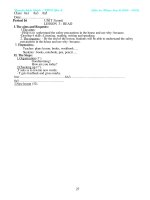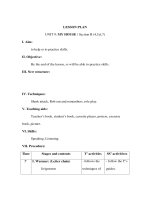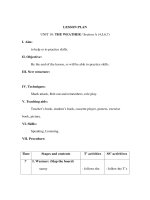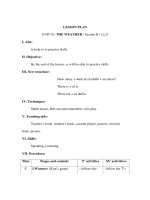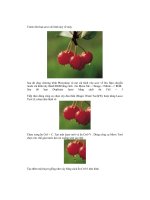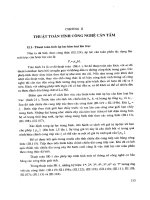Giáo trình Tiếng Anh chuyên ngành thư ký văn phòng English for secretaries: Phần 2
Bạn đang xem bản rút gọn của tài liệu. Xem và tải ngay bản đầy đủ của tài liệu tại đây (12.47 MB, 250 trang )
Ị
l
I N - H O U S E
i
C O R R E S P O N D E N C E
OBJECTIVES
•
Knowing well the form of Memo. mỉnutes, reports.
•
Talking about amount, figure, report or notice the events.
Reading and writing the Memo, minutes, report
•
Getting preciseness and carefulness in work.
CONTENTS
- Topics: VVriting the Memo/minutes, reports.
- Language: Form of Memo, minutes, reports. Repx)rting statements, form
of graph & chan, expressions of quantity and amount.
- Vocabulary : Abbreviations
- Skills work:
Talking about the facts, rewriting the things happened.
Translating the Memo, minutes, reports into Vietnamese.
Writing the memo, minutes, reports in the correct form.
- FoIlow úp : Filling in the blank
164
l.SNAPSHOT
[ME.ừ. L, nem. oi mtmormia lo be Itratmbtitd. gcnittCvc
fl|MMM| 1: inỈDÍợtnuilTOCOÍXỈ;ĩ • vihlui rcflDỈndcf
sỉ M IDMBMI witaco sóc oi AMuuicciooQr pwpoicd IBBHMMMÌ
l a ; MI Mu—Ị địylnnMlicn——t —loi b:amu.trêf
BỆ—wtađBB MÚM lót ÌMBỆMBBB qregtoắẾoo o:aoommuQicùcQ
thu eeatthH ANCIIM, adviioy, ertataMkpaHttcQanbg,
HTÌntnbr v*lgv HCTĨI, pmtat«H>rSìo«eSan>TVatte Arti
Talk about these questions
Ì. What is a memorandum?
2. What should be bom in mind when writing a memorandum?
3. What are important points in a memorandum?
4. What are the parts of a memorandum?
The Memorandum or Mcmo is a written íbrm of communication distributed
to people within an organization .
This can be inter-departmental, inter-office or inter-company as a whole.
- A memo is usually fairly short. ít should include enough so thát the
correct iníormation is communicated, bút should nót include anything extra
to this.
- A memo should include the following iníormation:
+ Who is the memo to ?
+ Who is the memo from?
+ What is the subject of the memo?
+ What is the date?
165
• Rules for writing Memo:
- Always keep your reader in mind and adapt your memo to his or ba
particular needs.
- Ten your reader the purpose of your memo át the outset
- Let your reader know why he or she should be concernẹd with the issue
in question this time.
- Express your personal or department point of view, bút avoid slanting
your assumptions, argument and presentation of opinions.
2. CONVERSATION
Realizing a Memo
ữ Listen and practice.
A : Can you tell me the differences betvveen a letter and a memorandum?
B : Certainly. A letter must be sém out of the company and must be mailed
or posted. A memorandum is a communication within an organization.
A : Should we use the layout we use for a letter when we write a
memorandum?
B : No, nót necessary. Usually we have a sét form vvhich is printed. We
just nu in the printed forms and send Ít to the person or the offices
concerned in the company.
A : ít seems quite easy to write a memorandum. Could you show me a
sample copy?
B : Of course, let me find one for you.
Memoranda
a/
MEMORANDUM
From: A. White
Ref: AW / DES
To:
Manager, Despatch Dept.
Dale: May 7, 2003
HARRISON BRQS. - THEIR ORDER NO. 472
Please examine these barrels, which have been returned to us with a
complaint thát they are soiled át the edges because of tom outer urappings. ì
await your comments.
166
b/
MEMORANDUM
From: Manager, Dispatch Dept.
Ref: DES / AW
To:
A.White
Date: May 9,2003
HARRISON BROS. - COMPLAINT
ì have investigated this complaint, and found thát the wrappings were, in
fact, nót úp to our usual standard. We are replacing the order.
Form of MEMO
MEMO
Date :
To : (Persons/ Dép.) .
From : (Person/ Co.)
Subịect:
(messages)
(signed)
MEMORANDUM
To: Ref:
From:
Subject:
(messages)
Date:...
167
Practice
AI Read the fol\owing memo and imagine both of you are divisional
managers to whom the memo is addressed:
Ì, What do you think the managing director's aims were in writing the memo?
2, What (if anything) are you expected to do as a result of reading ihe memo?
MEMORANDUM
From : The Managing Director
To :
Divisional Personnel Managers
Subịect:
Coffee - Making Facilities
Date:
13 th July, 20...
There have been a number of comments about the amount of coffee
consumed in our company. ì do nót want to sound as though ì am against
coffee-drinking :
indeed our personnel consultants have emphasized how
important coffee can be if you vvant an efficient and motivated office staff.
Bút time-saving machines for making coffee do exist.
We can expert a little opposition to the idea if we are nót careíul. You
can never be sure how the office staff will react. They might well take Ít
badly. In any case, we're thinking of putting in coffee machines. Please send
me a report.
BI Translate into Vietnamese:
Memo from : Managing Director 27.11.20...
To :
Heãd of General Administration Department
ì see from my diary thát the next Board meeting, 8 January, is the one
where we examine the whole question of the provision of secretarial services
throughout the fírm, and pinpoint weaknesses or waste of resources. ít is
usual for you to collect and generally act as a clearing house for suggestions.
My own observations which are relevant are as follow:
168
Ì, ì vvish we could replace the photocopier in use in the Buying
Department - vvhen ì call for a copy of a document Ít is almost illegible. The
machine should be replaced by a modern type of plain paper copier.
2. Morale seems to be very low in the typing pool. ì wonder whether the
purchase of a new word processing system with fewer employees doing the
same amount of vvork in a more interesting way would nót be an
improvement. The labor turnover is high, which vvould nót be an relatively
easy to implement a change-over.
ì think ì should have your report in by 2 January to give me time to
think over any points beíòre the meeting . ì will thereíore mark Ít in my diary
as receivable ôn or before thát date.
Cl Read this memo and complete Ít using the verbs in the box below
Fìy
take
send
meet
go
photK
To:
From :
Re :
We
Ellen
Michael
James's visit to the London office
(1) Jams ôn Monday, Ì August.
He
(2) to London from Edinburgh. ì don't know
the exact time of his ílight. ì
(3) him to check
the ílight details. He hasn't received a copy of the report yet, so ì
(4) him one this aíternoon. ì
(5) to
Frankfurt thát evening, so ì
(6) James to the airport
for his return ílight.
3. MINUTES
(ỉ Listen and practice
A : Hi, Mary. You have been a secretary for several years in this company.
Could you tell me what a secretary should do for a meeting or a coníerence?
169
B : Well, an important part of the duties of a secretary. ì think. is to do well
the preparation work for the meeting.
A : Then what should a secretary do to prepare for a meeting? Can you ten
me a bít more about Ít?
B : Fừst of an, the agenda should be prepared before the meeting. Then you
should ensure thát those entitled to be present are properly iníormed.
A : ì see, and how about the documents or the information?
B : AU the necessary documents and the iníormation relevant to the meeting
should be available, preíerably printed and distributed before the meeting.
A : And vvhat should a secretary do during the meeting?
B : Of course she should take minutes.
A : And after the meeting?
B : After the meeting she should type the minutes úp, and keep proper
records of the business transacted and the resolutions passed and also
implement many of the decision reached át the meeting.
A : Thank you very much. You are very helpíul.
B : Nót át all.
Talk about these questions
By whom are the minutes ơften prepared?
What should a secretary do to prepare a meeting or a conference?
What are the minutes \vritten for?
4. READING
What are there in the minutes?
Within most organizations, meeting among members of departments or
committees are a regular occurrence. Some meetings are held át íĩxed intervals
(such as weekly or monthly) and others are called for special reasons. Minutes
are vvritten record of everything thát transpires át a meeting. They are prepared
for the company files, for the reference of those in attendance, and for the
iníormation of absentees.
Minutes are prepared by a secretary who takes thorough notes during the
proceedings. In preparing the minutes, the secretary may include complete
versions of statements and papers read át the meeting.(copies are provided by
the member involved)
170
Writing minutes is a task thát calls for considerable ability in writing
good, clear and concise English. The minutes begins with a heading thát states
clearly the name of the body thát mét anđ when and where the meeting was
held. This is followed by a list of those who attended the meeting and, where
relevant, the offices they hold. Those entitled to attend bút who were unable to
do so should also be listed separately. The overall record of the meeting in
question should be allocated a reĩerence number. The minutes then record vvhat
took place át the meeting, and thereíòre start with a record of the formal
business át the beginning of the meeting, the approval and signing of the
minutes of the previous meeting and discussion ôn any item in thèm thát calls
for future comment. A formal record is then kept of all the decisions reached
ôn each item listed in the agenda, and át the end of the meeting the secretary
should record the time át which Ít closed.
The minutes of any meeting should contain certain basic facts.
- the name oi the organization
- the place, date, and tìme of the meeting
- \vhetherthe meeting is regular (monthly, special, etc.)
- the name of the person
presiding.
- a record of attendance (for small meetings - a list of those present or
absent, for large meetings - the number of members in attendance)
- a reference to the minutes of the previous meeting (a statement thát
they were read and either accepted or revised, or thát the reading was
dispensed with)
- an account of cãi reports, motions, or resolutỉons made (including all
necessary details and the results of votes taken)
- the date, time and place of the next meeting
- the time of
adịournment.
Formal minutes vvould include, in addition to greater detail, the names of
ai! those who make and second motions and resolutions, and the voting record
or each person present.
171
Example :
Minutes of the Meeting of the
CAPITOL IMPROVEMENTS COMMITTEE
The Foster Lash Company, Inc,
October 8, 20..
Presiding : Patricia Stuart
Present: Jay Townes
Sheila Gluck
Ellen Franklin
Samuel Browne
Lisa Woo
Absent: Fred Hoffman
Gina Marino
The weekly meeting of the capitol Improvements Committee of the
Foster Lash Company was called to order át 11 a.m in the coníerence room
by Ms. Stuart. The minutes of the meeting of October-1 were read by Mr.
Tovvnes and approved.
The main discussion of the meeting concerned major equipment thát
should be purchased by the end of the year. Among the proposals were these:
Ms.Woo presented information regarding three varieties of office
copying machines. Ôn the basic of her cost analysis and relative períbrmance
statistics, Ít vvas decided, by majority vote, to recommend the purchase of a
CBM X - 12 copier.
Mr. Brovvne presented a request from the secretarial staff for new
typewriters. Several secretaries have complained of major and frequent
breakdoxvns of their old machines. Ms. Franklin and Mr. Brone are lo further
investigate the need for nevv typewriters and prepare a cost comparison of
new equipment versus repairs.
172
The committee vvill discuss the advisablity of purchasing a small inhouse computer. The report will be presented by Sheila Gluck át the next
meeting, to be held ôn Octorber 15. 2003. át 11 a.m in the conference room.
The meeting adjourned át 11:45 a.m
Respectíully submitted
Ellen Franklin, Secretary
5. LANGUAGE STUDY
VVays of reporting in the minutes
Indirect speech
Somebody + V (simple past)
thát clause
V-ing
to infinitive
Reporting statements
said
explained
thát plastic bottles are easy to use.
He
pointed out
told him
Reporting suggestions
suggested
She
recommended using glass bottles.
Reporting commands
She
told him ị to get a quote from some suppliers.
Practice
AI Match what people said to how tí is reported
ì. Why don't vve use colored glass?
2. Could you find out the prices for blue and green glass?
3. ì don't think that's a very good idea. You can't see what's in the bottles.
173
4. Would Ít be more expensive?
5. We could have different colors for different lines.
6. ì think we should use glass.
a. She asked him to find out the prices for different colors.
b. He recommended using glass.
c. He \vondered if Ít would be more expensive.
d. She suggested using colored glass.
e. She said we could have different colors for different lines.
f. He disagreed.
Translate the following minute into Vietnamese.
Minutes of meeting
Present: James, Laura, Max, Nic, Olivia
1. Apologies for absence - AU, Mary
2. The minutes of the last meeting were agreed OH.
3. Packing of Bìack Musk bath oil
- James recommended using plastic bottles because they are light, easy to
pack and easy to transport. Furthermore, they do nót break.
- Olivia suggested glass bottles would give the bath oil a more upmarket image.
- Max pointed out thát glass is easier to recycle than plastic, James
\vondered if customers would actually bring bottles back for reíìlling .
- Laura pointed out thát if we use glass we will need to find a new supplier
as our present supplier only deals in plastics. She agreed to get quotes from
different suppliers in time for the next meeting.
4. Any other business - none
The next meeting vvill be ôn 15 March át 10.00.
6. WRITING
As secretary to the Highridge Tenants Association, prepare minutes
from the following note taken át the emergency meeting ôn May 4,2003.
1. Called to order 7:30 p.m .. lobby, by Ms. Gingold.
2. 102 members present, 13 absent.
3. Reading of minutes of last meeting dispensed with.
174
4. Officers' reports.
Vice-President read through the "red herring" sent by landlord to tenants.
Explained more difficult clauses. Explained lengthy court procedure before
actual cooperative offering can be made.
Treasure reported balance of $ 98.15. Observed need for minimum of $
500 to retain and attorney to negotiate with landlord - Requested :
member's with unpaid dues to see him after meeting.
5. Motions
The president called for a committee to search for a lawyer to represent
tenants. Motion made and caưied thát floor captains will constitute the
committee headed by the President.
Motion to meet again to vote ôn search committee's selection made
and carried.
6. Adịourned 9:30 p.m
7. REPORTS
Secretaries often summarize the things happened or the future plan to
summit to the Manager
And sometimes they write business reports át the end of month or year....
There are 5 types of business reports
1. A record report: merely states facts, describing the status of a company
or of a division of a company át a particular point in time.
2. A progress report: also states facts, tracing developments thát have
occuưed over a period of time.
3. A statistical: presents numerical data, usually in the form of charts,
tables and graphs.
4. An investigative report: is based ôn a study or investigation of a
particular situation or issue. Such a report presents the newly accumulated data,
Ít may also analyze the data.
5. A recommendation report: is an investigative report taken one step
íurther, providing speciíic recommendations based ôn the iníormation provided.
Contents
- First parơgraph:
Present the main idea clearly and concisely.
- Middle paragraphs: Develop the main point with supporting details
and iníormation.
175
- Final paragraph:
State your objective conclusion. lí called for, your
own comments and recommendations may be included ai the end.
Example:
TO: Mr. Marvin Dawson
FROM:
Jim Coates
DATE:
February 7, 03
SUBJECT: Report ô n Secretarial Staff O v e r t i m e f o r January.
As you requested, ì have computed the number of overtime hours
vvorked by the secretaries of the verious departments and the cost of thát
overtime to the company.
Department
Executive
Marketing
Accounting
Personnel
Employee
Ann Rogers
Wilma Toynbee
Maribel Cruz
Nicole Foire
Judy Hecht
TOTALS
Hourly
wage
$7,50
$7,50
5.00
5.00
6.00
Number
of times
6
5
8
8
10
37
Total
Total cost
hours
15
$168.75
14
$157.50
17
$127.50
$135.00
18
21
$189.00
85
$777.75
The cost of hiring a clerical assistant for 35 hours a week át $4.25 an
hour would be $148.75 or $595.00 and 140 hours a month. This would save
the company approximately $182.75 yet provide an additional clerical
hours.
8. READING
Alice Everett has prepared a draít of the end-of-year report tròm the
Marketing department, and has asked Karen Williams to type Ít úp. Read
through the extract below, and as you read, put a tick (V) in the True column if
the iníormation in the table is correct, or in the False column if the information
is incorrect.
176
END-OF-YEAR REPORT
FOR THE PERIOD Ì APRIL 2003 to 30 March 2004.
1. Personnel in the Marketing department
We have seen many personnel changes in the marketing Department
during the past year. Most oi the changes have been caused by retirement,
bút some of our key employees have moved to better-paid jobs.
Also, in the typing pool many of our secretaries have been tempted to
move to other companies and better salaries. ì recommend thát we hold a
review of general pay and conditions in the Marketing Department to try to
prevent this problem re-occurring.
2. Market research.
The results of our questionaire have now been collected and a detailed
analysis can be found in Appendix 1. In brief, none of the responses were
negative and a lót of thèm gave very useful information. The exercise was
therefore well worth while. A few of the replies even expressed a deíìnite
interest in ordering large numbers of our products.
3. Annual coníerence.
This year's conference was held in Bath, and all the delegates thought Ít
was a great success. Much of the discussion íocused ôn trade with European
countries and a little concerned trade with China.
4. Sales performance.
AU of the company's products have had a successíul year. Perhaps more
improtant....
True False
a, The main cause of personnel changes is low pay
b, Many secretaries have left for better-paid jobs
c, Alice Everett does nót want to hold a pay review
d, There have been several negative responses to the
questionnaire
e, Much useful iníòrmation was gained from the questionnaire
g, None of the replies were interested in the product.
177
h, The conference went very well
i, Most of the discussion was about China
k, Some of the company's products have been unsuccessful
_1
•
•
•
9. LANGUAGE STUDY
Expressions of quantity and amount
0
20% 50%
75%
none of
some of
90%
a lót of
100%
any noun.
most
all(o0
many of
c.nouns:
a few of
a little of
much of
Unc.nouns :
How can you understand the following sentences.
- AU the delegates considered Ít a great success.
- Most of the changes have been caused by retirement.
- A lót gave very useíul iníormation.
- Many of our secretaries have been tempted to move.
- Much of the discussion íbcused ôn trade with European countries.
- Some of our key employees have moved to better-paid jobs.
- A few of the replies expressed deíinite interest.
- A little of Ít concerned trade with China.
- None of the responses were negative.
of
Pair work
Look át the íollovving duties of Personal Assistant and secretaries.
Discuss how ntuch of your time is devoted to these actìvities, and how
much of other colleagues in your company.
Answering the phone
Draíting letters
Typing letters
Taking dictation
Receiving visitors
Attending meetings
Writing the minutes of meetings.
178
Handling the mail
Instructing others
Other activities.
Here are some examples
ì ansvver a lót of telephone calls.
ì only answera few telephone calls, bút ì draft a lót o/letters.
ì also draít a lót o/letters and also ansvver some of the telephone calls.
FOLLOW ÚP
1. Translate the following report into Vietnamese:
Report ôn coffee - making and breaks
ít is very interesting thát the coffee making hãbits of our employees
have been noticed by other people in the company. ít appears as if the time
taken úp by the making of coffee could be put to more productive use. We
have also known for several years thát there have been a number of problems
connected with the motivation of our workforce bút the role played by
coffee-drinking has so far nót been clarified.
In one or ĩwo departments, staff seen to talk about nothing else bút
coffee breaks: how long is Ít tin the break, whose tùm is Ít to make Ít? etc.
The uníòrtunate development has been discussed with the heads of
department in my division ôn several occasions. They believe the subject of
automated coffee machines, one for each department for example, is nót very
popular with a large number of staff. The staff think thát the company vvould
be trying to make money out of thèm. So ì think management could be
misunderstood.
None the less, ì feel thát we should try and limit the coffee-breaks. We
should try to prevent the staff from gathering round the coffee-making area
and chatting for so long. ì wonder if you have heard or the experience of our
American sister company. They have a central coffee-making facility for ai]
the divisional offices. This is then brought to the staff át their desks. In this
way of making vvorking time more effícient.
179
2. Write a memo for your class meeting
Abbreviations
- ABT(about)
- ABV (above)
- ACPT (accept)
- ADDTN (addition)
- ADRSEE (addressee)
- AD (advertise)
- ADV (advertisement)
- AGN (again)
- AGR (agree)
- AMT (amount)
- ANS (answer)
- APPROX (approximate)
- ARVL (arrival)
- BTR (better)
- UK (United Kingdom)
- BYR (buyer)
- FIG (figure)
- FOC (free of charge)
- QLTY (quality)
- QNTY / QT (quantity)
- QTN QUTN (quotation)
- RCPT(receipt)
New words
Nouns:
- absentee:
- adịournment:
- minute:
- agenda:
- resolution:
-task:
- approval:
180
người vắng mặt
ngừng họp
biên bản, giác thư
chương trình nghị sự
nghị quyết
công việc
chấp thuận
Verbs:
- accumulate:
- investigate :
- flow:
- pinpoint:
- allocate:
- implement:
- entitle :
Adiectives:
- authoritative :
- tedious :
- anonymous:
- impersonal:
- cumulative :
- relevant to ....
- cai! for:
tích lũy, gom góp
điều tra
chày, theo dòng
xác định
phân phối
thực hiện
được quyển
có vẻ quan cách
mệt mỏi
nặc danh
vô nhân xưng
tăng tiến
liên quan tới
đòi hỏi
E N V E L O P E S
LETTER
A N D
P A R T S
OBJECTIVES
• Knowing vvell the letter form and letter parts, addressing envelopes.
• Talking about the order of the letter parts, nay of opening and
closing a letter.
Layouting a letter in three styles, and addressing envelopes.
CONTENTS
- Topics: Addressing envelopes, letter parts, letter laỵouts.
- Language: Letter form, envelopes, letter layouts.
- Vocabulary: Countries and Capitals, Salutation and ending.
- Skills work:
Understanding information in envelopes
Talking about the styles of letter layout, order of letter parts.
Addressing envelopes and laying out the letters correctly
- Follow úp: Correcting the mistakes
1. ADDRESSING AN ENVELOPE
ỉ,
182
- Have you ever exchanged iníormation by writing letters?
- Is Ít important to address an envelope correctly? Why? Why nót?
- Tell me the way to address an envelope in your country?
- Where is the stamp often stuck ôn the envelope?
2. CONVERSATION
How to address an envelope
A : Just read this receiver's address, Mary.
B : (Reads the address ôn the envelope)
That's right. First you should write the receiver's name in full with Mĩ. .Mrs..
Miss or Ms. "David" is the given name and "Smith" is the surname or
family name.
A : Yes, bút we write our Chinese name in a different way. Mv name is Li
Minhua. L i is my surname and Minhua is my given . People can me
Miss Li or Minhua.
183
B : Then underneath the receiver's name, we write the name o i the oííice or an
organization if Ít is a business letter.
A : And we should write the name of the office or the departmeni íirst if there
are both the names of the office and the company?
B : That's right. Write thèm ôn two lines if you have both names.
A : Then write the house number, name of the street or road. the city, the statc
postcode and finally the country?
B : Yes. The principle is thát you start ííom the smallest unit to the largest unit.
A : So, i f the company is in Room Ì 405, ì should first write Ì 405, then the
house number, the name of the street and so ôn?
B : That's right.
A : It's funny. When ì write the sender's address in Chinese ôn the envelope, ì
always put Ít át the right-hand corner át the bottom. Bút when ì write Ít in
English ì should put Ít át the upper left-hand corner.
B : Bút no matter whether Ít is vvritten in Chinese or in English, the stamp is
always stuck át the upper right-hand corner.
A : That's trúc
B : So the envelope is written perfectly. It'd be even better if you can type Ít.
A : r u do Ít now.
Envelope addresses are written in a similar way to inside addresses, bút for
letter in or going to the UK, the postcode is usually written ôn a line by
itself át the end of the address, and the name of both the town and the
country are written in capital letter .
Example:
a.
Mr. G. Penter
49 Memorial Road
ORPINGTON
Kem
BR6 9UA
b.
Messrs w . Brovvnlo\v Co.
600 Grand Street
184
LONDON
WIN 9UZ
UNITED KINGDOM
c.
FLANAGAN'S DEPARTMENT STORE
12207 Sunset Strip
Los Angeles, CA 91417
Attention Ms. Terv Roberts
Registered Mail
Ketchurn Collection Agency
1267 Hollywood Boulevard
Los Angeles, CA 91401
TheưSA
3. READING
Here are a few simpìe rules about the best wa\ ofaclclressinq an envelope:
- Use separate lines for the name or company, posl box or house number,
and Street, town and country or city, state, postcode and country.
- The number precedes the street name. Words like Street, Square, avenue
are written separately, each word starting with a capital letter.
- Commas may be placed át the end of each line (close punctuation), or
only betxveen city and siate or county (open punctuation). Use the same form
as in the letter.
- The British Postcode is written below the address. The American Zìp
code is ôn the same line as city and state.
- The post code should always be the last of the iníòrmation in the
address, and often in block capitals.
- Do nót use stops or any other punctuation marks between or át the end
of the characters of the postcode.
- Always leave a clear space, át least equivalent to one character, bet\veen
the two halves of the postcode.
-
Never underline the postcode.
Talk about the questions:
Ì. Where is the house number placed ôn an envelope?
185
2. How can you understand the words "postcode" and "Zip code" ?
3. How can you write the post code in the addtess?
4. FORM OF AN ENVELOPE
Stamp
Sender's address.
Receiver's name
Company's name
House No., Street.
City, state postcode
COƯNTRY
Notes : Postal indications are
Air mail
Registered
Express
Coníidential
Urgent
Private
To be called for
Pleased forward
Fragile-with care
Messers Black & Sons
RO. Box 135
Liverpool
AB3 DE 4
Registered
C.V.Tapatex
Jl Tiang Bendera 4
Jakarta
Indonesia
186
AIR M A I L
Faster Services Inc.
82 West 10'" Street
San Francisco, Calif, 27044
USA
How can you understand alỉ above enveỉopes.
Read the following envelope and then ansvver the questions
FLANAGAN"S DEPARTMENT STORE
12207 Sunset Strip
Los Angeles, CA 91417
Registed May
Attention:Ms. Tery Roberts
Ketchum Collection Agency
1267 Hollywood Boulevard
Los Angeles, CA 91401
TheUSA
1. Who is the sender of the letter?
2. Who is the recipient of the letter?
3. Where is the letter sém to ?
4. What is "CA 91401" shown ôn thát envelope?
Stamp
ị
5. ữ LISTENING
Listen to the dialogite anci then fill in the blanks
A : Hi, Mary.
B : Hi, Li Minhua.
A : ì was just (Ì)
if you could do me a (2)
B : Certainly. What can ì do for you?
A : Pin vvriting a (3)
B : What are you applying for a job or (4)
A : Well, ì read an (5)
the United States offers (6)
to go.
B : Do you want (7)
?
In an English nexvspaper. A college in
for secretaries, and I'd like
there this summer?
A : Yes. Fd love to . Could you help me to check the envelope Pirst and
see if there are (8)
?
B : AU right. Where is the envelope?
A : Here Ít is.
188
